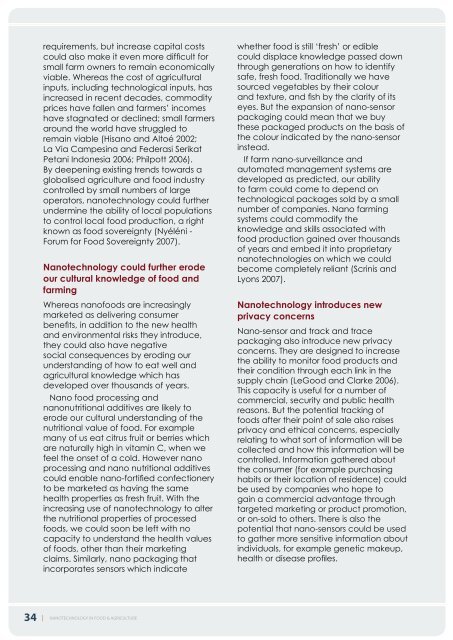Nanotechnology in Food & Agriculture - denix
Nanotechnology in Food & Agriculture - denix
Nanotechnology in Food & Agriculture - denix
You also want an ePaper? Increase the reach of your titles
YUMPU automatically turns print PDFs into web optimized ePapers that Google loves.
34<br />
requirements, but <strong>in</strong>crease capital costs<br />
could also make it even more difficult for<br />
small farm owners to rema<strong>in</strong> economically<br />
viable. Whereas the cost of agricultural<br />
<strong>in</strong>puts, <strong>in</strong>clud<strong>in</strong>g technological <strong>in</strong>puts, has<br />
<strong>in</strong>creased <strong>in</strong> recent decades, commodity<br />
prices have fallen and farmers’ <strong>in</strong>comes<br />
have stagnated or decl<strong>in</strong>ed; small farmers<br />
around the world have struggled to<br />
rema<strong>in</strong> viable (Hisano and Altoé 2002;<br />
La Via Campes<strong>in</strong>a and Federasi Serikat<br />
Petani Indonesia 2006; Philpott 2006).<br />
By deepen<strong>in</strong>g exist<strong>in</strong>g trends towards a<br />
globalised agriculture and food <strong>in</strong>dustry<br />
controlled by small numbers of large<br />
operators, nanotechnology could further<br />
underm<strong>in</strong>e the ability of local populations<br />
to control local food production, a right<br />
known as food sovereignty (Nyéléni -<br />
Forum for <strong>Food</strong> Sovereignty 2007).<br />
<strong>Nanotechnology</strong> could further erode<br />
our cultural knowledge of food and<br />
farm<strong>in</strong>g<br />
Whereas nanofoods are <strong>in</strong>creas<strong>in</strong>gly<br />
marketed as deliver<strong>in</strong>g consumer<br />
benefits, <strong>in</strong> addition to the new health<br />
and environmental risks they <strong>in</strong>troduce,<br />
they could also have negative<br />
social consequences by erod<strong>in</strong>g our<br />
understand<strong>in</strong>g of how to eat well and<br />
agricultural knowledge which has<br />
developed over thousands of years.<br />
Nano food process<strong>in</strong>g and<br />
nanonutritional additives are likely to<br />
erode our cultural understand<strong>in</strong>g of the<br />
nutritional value of food. For example<br />
many of us eat citrus fruit or berries which<br />
are naturally high <strong>in</strong> vitam<strong>in</strong> C, when we<br />
feel the onset of a cold. However nano<br />
process<strong>in</strong>g and nano nutritional additives<br />
could enable nano-fortified confectionery<br />
to be marketed as hav<strong>in</strong>g the same<br />
health properties as fresh fruit. With the<br />
<strong>in</strong>creas<strong>in</strong>g use of nanotechnology to alter<br />
the nutritional properties of processed<br />
foods, we could soon be left with no<br />
capacity to understand the health values<br />
of foods, other than their market<strong>in</strong>g<br />
claims. Similarly, nano packag<strong>in</strong>g that<br />
<strong>in</strong>corporates sensors which <strong>in</strong>dicate<br />
| NANOTECHNOLOGY IN FOOD & AGRICULTURE<br />
whether food is still ‘fresh’ or edible<br />
could displace knowledge passed down<br />
through generations on how to identify<br />
safe, fresh food. Traditionally we have<br />
sourced vegetables by their colour<br />
and texture, and fish by the clarity of its<br />
eyes. But the expansion of nano-sensor<br />
packag<strong>in</strong>g could mean that we buy<br />
these packaged products on the basis of<br />
the colour <strong>in</strong>dicated by the nano-sensor<br />
<strong>in</strong>stead.<br />
If farm nano-surveillance and<br />
automated management systems are<br />
developed as predicted, our ability<br />
to farm could come to depend on<br />
technological packages sold by a small<br />
number of companies. Nano farm<strong>in</strong>g<br />
systems could commodify the<br />
knowledge and skills associated with<br />
food production ga<strong>in</strong>ed over thousands<br />
of years and embed it <strong>in</strong>to proprietary<br />
nanotechnologies on which we could<br />
become completely reliant (Scr<strong>in</strong>is and<br />
Lyons 2007).<br />
<strong>Nanotechnology</strong> <strong>in</strong>troduces new<br />
privacy concerns<br />
Nano-sensor and track and trace<br />
packag<strong>in</strong>g also <strong>in</strong>troduce new privacy<br />
concerns. They are designed to <strong>in</strong>crease<br />
the ability to monitor food products and<br />
their condition through each l<strong>in</strong>k <strong>in</strong> the<br />
supply cha<strong>in</strong> (LeGood and Clarke 2006).<br />
This capacity is useful for a number of<br />
commercial, security and public health<br />
reasons. But the potential track<strong>in</strong>g of<br />
foods after their po<strong>in</strong>t of sale also raises<br />
privacy and ethical concerns, especially<br />
relat<strong>in</strong>g to what sort of <strong>in</strong>formation will be<br />
collected and how this <strong>in</strong>formation will be<br />
controlled. Information gathered about<br />
the consumer (for example purchas<strong>in</strong>g<br />
habits or their location of residence) could<br />
be used by companies who hope to<br />
ga<strong>in</strong> a commercial advantage through<br />
targeted market<strong>in</strong>g or product promotion,<br />
or on-sold to others. There is also the<br />
potential that nano-sensors could be used<br />
to gather more sensitive <strong>in</strong>formation about<br />
<strong>in</strong>dividuals, for example genetic makeup,<br />
health or disease profiles.
















